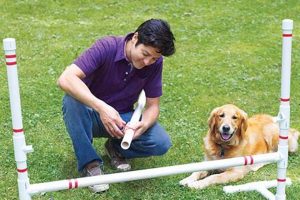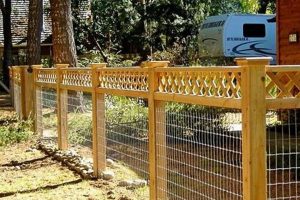The concept encompasses the creation of canine resting places through self-directed construction methods. These projects involve utilizing readily available materials and individual skills to provide comfortable and personalized sleeping arrangements for pets. An instance includes repurposing an old sweater to create a soft, enclosed bed suitable for smaller breeds.
Constructing bespoke dog beds offers several advantages, including cost-effectiveness and the ability to customize the size, shape, and materials to suit a specific animal’s needs and preferences. Historically, homemade pet furnishings have been a prevalent practice, reflecting resourcefulness and a desire to provide individual care.
Subsequent sections will examine various construction techniques, material selection considerations, and safety precautions applicable to the fabrication of individualized canine bedding.
Tips for Successful Canine Bed Construction
The following suggestions aim to enhance the quality and safety of homemade pet beds, ensuring both canine comfort and project longevity.
Tip 1: Prioritize Non-Toxic Materials. When selecting fabrics and fillings, ensure they are free from harmful chemicals or dyes. Opt for natural, hypoallergenic options to minimize potential allergic reactions or skin irritations in sensitive animals.
Tip 2: Accurately Measure the Animal. Obtain precise measurements of the dog’s sleeping posture length and width when fully stretched out to determine optimal bed dimensions. Add a minimum of six inches to each dimension for adequate comfort and movement.
Tip 3: Reinforce Seams. Utilize durable thread and a robust stitch to secure all seams, preventing premature tearing or unraveling. Double-stitching high-stress areas, such as corners and edges, will further extend the bed’s lifespan.
Tip 4: Incorporate a Washable Cover. Design the bed with a removable, machine-washable cover to facilitate regular cleaning and hygiene maintenance. This is particularly important for animals prone to shedding or those spending time outdoors.
Tip 5: Consider Joint Support. For senior or arthritic dogs, integrate orthopedic foam or memory foam padding to provide enhanced joint support and alleviate pressure points. Ensure the foam density is appropriate for the animal’s weight and size.
Tip 6: Implement Anti-Slip Features. Affix a non-slip material, such as rubberized fabric or adhesive pads, to the bed’s base to prevent it from sliding on smooth surfaces. This enhances stability and reduces the risk of injury.
Tip 7: Evaluate Chew Resistance. If the animal exhibits destructive chewing behaviors, select durable, chew-resistant materials for the bed’s construction. Avoid small parts or embellishments that could be ingested.
Adherence to these recommendations contributes significantly to the creation of a safe, comfortable, and lasting resting place for canine companions.
The subsequent section will offer concluding remarks regarding the benefits and considerations associated with personalized pet bed fabrication.
1. Size and dimensions
The accurate determination of size and dimensions is paramount within the context of custom-built canine bedding. These measurements directly impact the animal’s comfort, posture, and overall well-being, making it a crucial initial consideration.
- Internal Bed Dimensions
The internal area must accommodate the dog’s full body length and width when lying in its preferred sleeping position. Insufficient space can lead to discomfort, restlessness, and inadequate rest. For example, a Great Dane requires significantly larger dimensions than a Chihuahua.
- External Bed Dimensions
These dimensions dictate the bed’s footprint within the designated area. Considerations include available floor space, proximity to furniture, and ease of navigation within the room. A bulky bed may impede movement or create obstructions.
- Height Considerations
The height of the bed, particularly the sides, can impact accessibility for senior dogs or those with mobility issues. Excessively high sides may pose a barrier, while a low-profile design offers easier entry and exit. The height of any bolsters also influences the dog’s sense of security and comfort.
- Dimension Tolerances
When executing construction, precise measurements and adherence to dimensional tolerances are critical. Variations can result in an uneven sleeping surface, structural instability, or aesthetic inconsistencies. A small error in cutting materials can compound, ultimately affecting the finished product’s usability.
Failing to account for appropriate size and dimensions renders the exercise of constructing personalized canine bedding ineffective. The bed, regardless of material quality or aesthetic appeal, will not serve its intended purpose if it does not adequately accommodate the animal’s physical needs and spatial constraints. Therefore, accurate measurement and planning are indispensable preliminary steps.
2. Material suitability
The selection of appropriate materials constitutes a foundational aspect of successful personalized canine bedding. This decision directly impacts the bed’s durability, comfort, hygiene, and the animal’s overall health and safety.
- Fabric Type
The outer fabric determines the bed’s resistance to wear, tear, and staining. Durable options, such as canvas or denim, withstand frequent use and washing. Softer materials, like fleece or flannel, offer enhanced comfort but may require more frequent replacement. The breathability of the fabric also influences temperature regulation, crucial for the animal’s comfort in varying climates.
- Filling Material
The internal filling provides cushioning and support. Options range from inexpensive polyester fiberfill to more supportive memory foam or orthopedic foam. Fiberfill is lightweight and easily washable but may flatten over time. Memory foam conforms to the animal’s body, relieving pressure points, but can be more expensive and require specialized cleaning. Cedar chips offer natural insect repellent properties but may be unsuitable for animals with allergies.
- Water Resistance
For animals prone to accidents or outdoor use, water-resistant or waterproof materials are essential. These materials prevent moisture from penetrating the bed, reducing the risk of bacterial growth and unpleasant odors. Waterproof linings can be incorporated beneath the outer fabric to provide an additional layer of protection. However, it’s crucial that water-resistant materials remain breathable to avoid trapping moisture and causing skin irritation.
- Allergen Considerations
Animals with allergies require careful material selection to minimize potential reactions. Hypoallergenic fabrics, such as organic cotton or bamboo, reduce exposure to common allergens. Similarly, hypoallergenic fillings, like buckwheat hulls or specialized synthetic fibers, can prevent allergic responses. Regular washing in hot water further minimizes allergen buildup.
The careful consideration of these material-related facets is indispensable for creating customized canine beds that are both functional and safe for the animal. A failure to prioritize material suitability can lead to discomfort, hygiene problems, or even adverse health consequences. Therefore, material selection should be guided by the animal’s specific needs and the intended use of the bedding.
3. Washability
Washability is a pivotal element within the sphere of personalized canine bedding. The inherent connection stems from the practical necessity of maintaining hygiene and mitigating the accumulation of allergens and pathogens within a dog’s sleeping environment. The inability to thoroughly clean a dog bed results in the proliferation of bacteria, dust mites, and unpleasant odors, potentially impacting both the animal’s and the owner’s health. For example, a bed constructed with non-washable materials would necessitate frequent, costly replacements, negating the economic advantages often associated with bespoke construction.
Integrated washability can be achieved through several design and material choices. Removable, machine-washable covers, constructed from durable fabrics such as canvas or denim, provide a practical means of regular cleaning. Alternative approaches involve utilizing water-resistant inner linings to protect the filling material from spills and accidents, allowing for spot cleaning as needed. Examples include crafting a bed with a zippered outer cover or using a waterproof liner beneath a washable fabric layer. The choice depends on the pet’s habits and the owner’s preferred cleaning frequency.
The incorporation of washability into self-made canine bedding provides distinct benefits. It enhances hygiene, prolongs the bed’s lifespan, and allows for cost-effective maintenance. While challenges may arise in the selection of appropriate, durable, and easily washable materials, the long-term advantages substantially outweigh the initial planning and execution effort. The absence of washability undermines the goals of individualization and cost savings, highlighting its crucial role.
4. Durability
Durability, in the context of homemade canine bedding, represents the bed’s capacity to withstand sustained use, environmental factors, and the animal’s inherent behaviors, such as chewing, scratching, and general movement. The lifespan of a commercially purchased or handcrafted bed is directly proportionate to the quality and resilience of its constituent materials and construction. A lack of durability results in premature degradation, necessitating frequent repairs or replacements, thereby negating the economic and personalized benefits of the do-it-yourself approach. For instance, a bed constructed with loosely woven fabric and inadequately reinforced seams will quickly succumb to wear, leading to seam separation, stuffing expulsion, and overall structural failure.
Achieving durability necessitates a conscientious selection of materials known for their robust properties. Heavy-duty fabrics like canvas, denim, or tightly woven upholstery fabrics offer superior resistance to tearing and abrasion. Reinforced stitching techniques, employing durable threads and multiple passes, fortify seams against stress. The choice of filling materials also influences durability; high-density foams or resilient fiberfill retain their shape and support longer than low-quality alternatives. Further, considering the animal’s specific tendencies is essential. For dogs prone to chewing, selecting chew-resistant fabrics and reinforcing vulnerable areas minimizes damage. For outdoor use, water-resistant materials protect against moisture and degradation.
In summary, durability is an indispensable attribute of effective custom-built canine bedding. The intentional integration of robust materials and construction methods ensures the bed withstands the rigors of daily use, providing a long-lasting and comfortable resting place for the animal. Prioritizing durability yields a greater return on investment, minimizing the need for frequent replacements and aligning with the principles of sustainable consumption and resourceful craftsmanship.
5. Comfort features
Comfort features are integral to the success of canine bedding projects. These characteristics directly influence the animal’s willingness to use the bed and the quality of rest obtained. A well-designed resting place addresses the dog’s physical needs and behavioral preferences, leading to improved well-being. For example, an older dog suffering from arthritis benefits from orthopedic foam support, while a smaller dog may prefer a bed with raised sides to provide a sense of security. These adjustments move beyond mere aesthetics to enhance the bed’s functional value.
Specific comfort features can include the addition of memory foam for pressure relief, bolsters for head support, or cooling gel pads for temperature regulation. The incorporation of familiar scents, such as the owner’s clothing, can further enhance the dog’s sense of security and comfort. The careful selection and implementation of these comfort enhancements can significantly elevate a utilitarian pet bed into a preferred resting location. Ignoring the comfort aspects of the design can lead to the dog rejecting the bed, rendering the construction effort ineffective.
In conclusion, comfort features are not optional additions but essential components. Thoughtful consideration of the dog’s individual needs and preferences is vital when constructing a resting place. The integration of these features contributes directly to the bed’s usability and the animal’s overall satisfaction, optimizing the value of a customized design.
6. Safety considerations
Safety represents a paramount concern in the execution of canine bedding projects. The selection of inappropriate materials or flawed construction techniques can pose significant risks to the animal’s health and well-being. Therefore, meticulous attention to safety protocols is indispensable throughout the design and fabrication process.
- Non-Toxic Materials
The utilization of non-toxic materials is of utmost importance. Fabrics, fillings, and adhesives must be free from harmful chemicals, dyes, or volatile organic compounds (VOCs) that could be ingested or inhaled by the animal. Instances of toxic material usage can result in allergic reactions, skin irritations, or more severe health complications. Formaldehyde-free foams and natural, untreated fabrics are preferable alternatives.
- Absence of Small Parts
The exclusion of small, detachable components is crucial, particularly for animals prone to chewing. Buttons, zippers, ribbons, or other embellishments present a choking hazard if ingested. Securely fastening all seams and avoiding the use of easily removable decorations mitigates this risk. Regular inspection of the bed for loose parts is also advisable.
- Proper Ventilation
Ensuring adequate ventilation within the bed’s construction is essential. Stuffing materials that restrict airflow can create a breeding ground for mold and bacteria, leading to respiratory issues or skin infections. Breathable fabrics and well-ventilated fillings promote air circulation and prevent moisture buildup. Selecting materials with inherent antimicrobial properties can further enhance hygiene.
- Structural Integrity
Maintaining structural integrity is vital to prevent collapse or instability. A poorly constructed bed can pose a fall risk, particularly for senior dogs or those with mobility impairments. Reinforcing seams, utilizing durable materials, and ensuring a stable base contribute to the bed’s overall safety. Regularly assessing the bed for signs of wear or damage is recommended.
The multifaceted nature of safety underscores its importance in all phases of personalized pet bed construction. The integration of these considerations ensures the final product provides a comfortable and secure resting environment for the canine companion. A failure to prioritize safety can have significant, adverse consequences for the animal’s health.
7. Cost-effectiveness
The connection between self-directed canine bedding construction and fiscal prudence is significant. The impetus behind many undertakings lies in the potential for substantial savings compared to retail prices. Purchasing pre-made dog beds, particularly those of higher quality or specialized design, can represent a considerable expense. The alternative approach, employing do-it-yourself methodology, allows individuals to leverage existing resources, repurpose materials, and minimize outlay. For example, utilizing discarded furniture cushions, upcycled fabrics, and reclaimed lumber can dramatically reduce material costs, thereby lowering the overall financial commitment.
The degree of monetary advantage is contingent upon several variables, including material selection, the complexity of the design, and the builder’s skill level. Opting for less expensive, readily available materials, such as repurposed textiles or basic foam padding, further enhances savings. The simplification of design, avoiding intricate patterns or elaborate embellishments, reduces labor time and material wastage. Conversely, the incorporation of premium materials, such as orthopedic foam or high-end fabrics, while potentially increasing comfort and longevity, proportionally raises the project’s cost. Skillful execution, minimizing errors and material waste, is crucial for realizing maximum cost efficiency. A poorly executed project, requiring repeated material purchases or professional assistance, diminishes the initial financial benefit.
In summary, the pursuit of fiscal efficiency constitutes a primary motivator for engaging in personalized canine bedding construction. While the magnitude of savings varies based on specific choices and execution, the potential for significant cost reduction remains a compelling advantage. The successful alignment of material selection, design simplicity, and skillful construction practices directly contributes to the realization of optimal economic benefit. This understanding reinforces the value proposition of the do-it-yourself approach as a viable alternative to commercially available pet products.
Frequently Asked Questions
The following section addresses commonly encountered queries regarding personalized canine bedding, providing clarity and practical guidance.
Question 1: What constitutes the most appropriate dimensions for a homemade dog bed?
Ideal dimensions are determined by the animal’s size and sleeping habits. Measurements should accommodate the dog’s full length and width in its typical sleeping posture, adding a minimum of six inches to both dimensions for comfort and movement.
Question 2: Which materials are deemed safest for constructing canine bedding?
The safest materials consist of non-toxic fabrics and fillings devoid of harmful chemicals or dyes. Natural, hypoallergenic options such as organic cotton or hypoallergenic fiberfill minimize the risk of allergic reactions or skin irritations.
Question 3: How can washability be effectively incorporated into the design of a self-made dog bed?
Washability is achieved through the integration of removable, machine-washable covers constructed from durable fabrics like canvas or denim. Utilizing a water-resistant inner lining beneath the cover further protects the filling material.
Question 4: What methods can be employed to enhance the durability of a personalized dog bed?
Durability is enhanced through the selection of robust materials, such as heavy-duty fabrics and high-density foams. Reinforced stitching techniques, particularly in high-stress areas, further extend the bed’s lifespan.
Question 5: Are orthopedic features necessary for all canine bedding projects?
Orthopedic features, such as memory foam or orthopedic foam padding, are particularly beneficial for senior dogs or those with joint problems. However, all animals benefit from adequate cushioning and support. Evaluate the animals specific needs when determining necessity.
Question 6: What are the essential safety precautions to consider when constructing a dog bed?
Essential safety precautions encompass the utilization of non-toxic materials, the elimination of small, detachable parts, ensuring proper ventilation, and maintaining structural integrity to prevent collapse or instability.
Thorough consideration of these queries contributes to the creation of safe, comfortable, and enduring resting places for canine companions.
The following section will provide concluding remarks.
Conclusion
This exposition has detailed the multifaceted nature of diy dog bed ideas, emphasizing the critical considerations of size, material, washability, durability, comfort, safety, and cost-effectiveness. Each element contributes directly to the creation of a functional and appropriate resting place for canine companions. Successful implementation requires diligent planning and execution.
The preceding analysis underscores the importance of informed decision-making in personalized pet product construction. By adhering to established guidelines and prioritizing the animal’s well-being, individuals can effectively provide comfortable, safe, and economically viable bedding solutions. Continued research and adherence to evolving best practices remain essential for optimizing outcomes in this domain.







